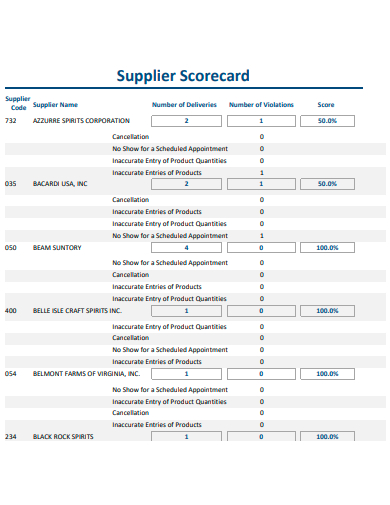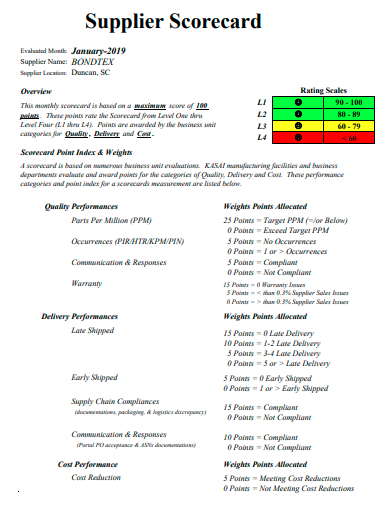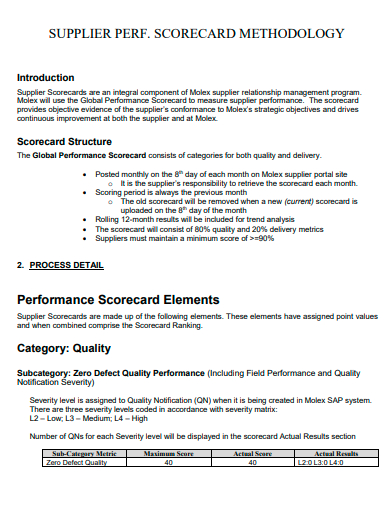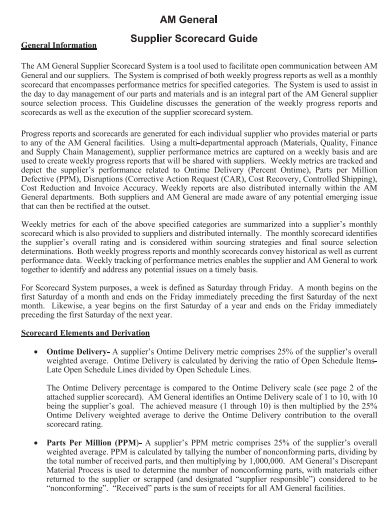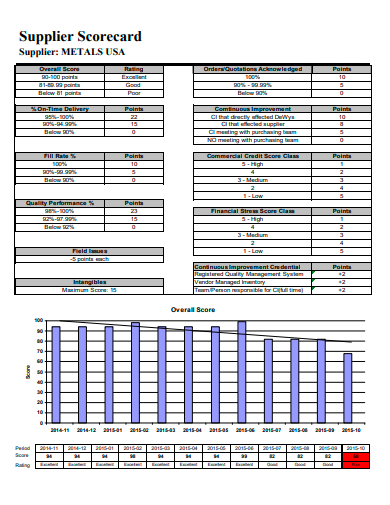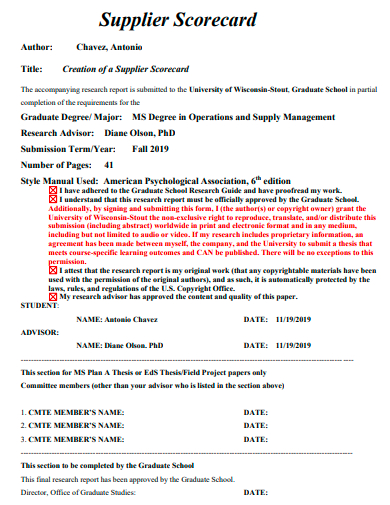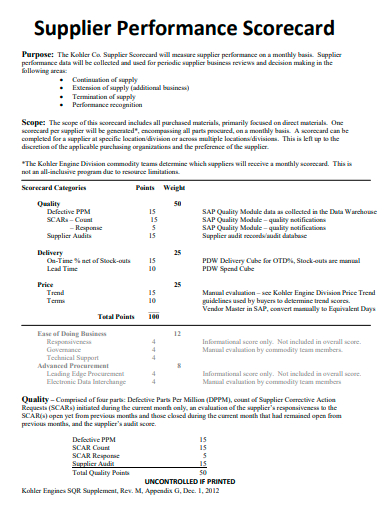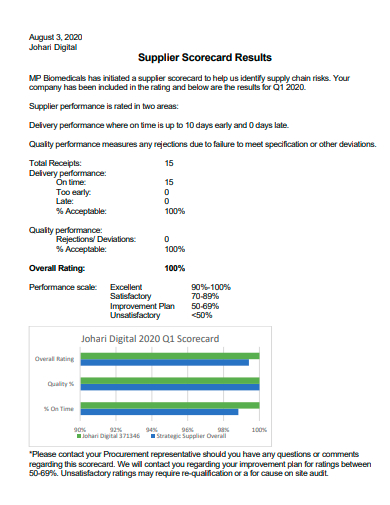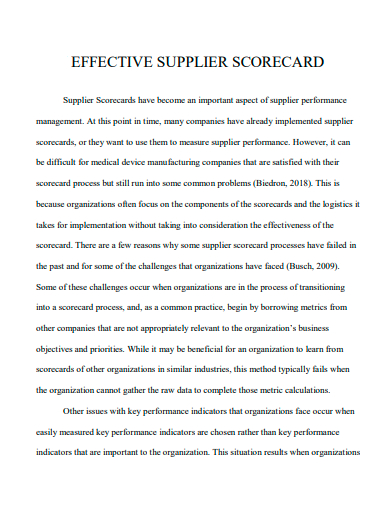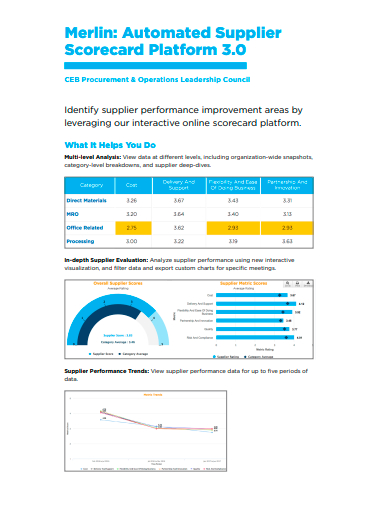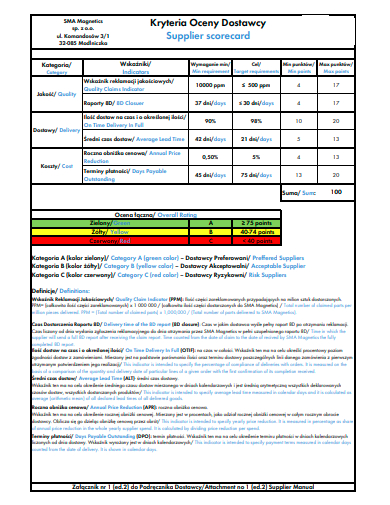Suppliers or vendors are an important part of a business’s supply chain because they are the ones who provide and deliver the necessary ingredients or materials required for the production of their products. It is also essential for the company and its suppliers to establish consistent communication and transparency to ensure that there will be no late or missed deliveries of orders. Companies and businesses use supplier scorecards to monitor their relationships with their vendors and evaluate their performance.
FREE 10+ Supplier Scorecard Samples
1. Supplier Scorecard Template
2. Basic Supplier Scorecard
3. Supplier Scorecard Example
4. General Supplier Scorecard
5. Formal Supplier Scorecard
6. Supplier Scorecard in PDF
7. Supplier Performance Scorecard
8. Supplier Scorecard Results
9. Effective Supplier Scorecard
10. Automated Supplier Scorecard Platform
11. Printable Supplier Scorecard
What Is a Supplier Scorecard?
A supplier scorecard is also known as a vendor scorecard that enables a company to track the vendor performance evaluation results of its suppliers by dividing them into quantifiable criteria and categories. This scorecard allows companies to evaluate the key parameters and determine if the supplier is performing well or not. Suppliers are one of the crucial factors for an effective supply chain and supplier scorecards can provide businesses with information that determines whether a vendor can provide them with high-quality services and products or not.
How to Create a Supplier Scorecard
In supply chain management, a supplier scorecard provides the comparison of the performance of various suppliers or vendors, helping a business to decide which suppliers to work with for producing a certain product or service. The information provided in the supplier scorecard can also be used to enable companies to make more informed decisions about how an established business partnership agreement with each supplier will work and the price the company has to pay for the goods or services they will provide.
Step 1: Determine the Appropriate KPIs
To measure the performance of your suppliers, determine which key performance indicators or KPIs to use. Each business utilizes different KPIs for each of its vendors and is based on its industry, the business’s supply requirements, and the overall performance of its suppliers.
Step 2: Decide on Your Grading Scale
The grading scale of your supplier scorecard is the visual representation of their value to a company. Companies can use the traditional lettering scale or the number scale. Decide first on how you wish to scale each of your vendors, the number of opportunities you will provide for improvements, and what each grade means or signifies.
Step 3: Collect Your Guiding Documents and Review
Your guiding documents refer to contract agreements that define the relationship between a vendor and a business. Some of these guiding documents are the service level agreement, short or long-term contract, and a payment invoice.
Step 4: Start Your Supplier Evaluation
After determining your KPIs, choosing a grading scale, and gathering your guiding documents, you can now use your supplier scorecard to evaluate each of your vendors. Your evaluation will help you determine which vendor lacks in certain areas and decide whether to continue your business relationship with them or not.
FAQs
What are the KPIs that can be included in a supplier scorecard?
The KPIs you can use in your supplier scorecard is the delivery performance which tracks the consistency of timely deliveries, product quality control which tracks the overall quality of the supplies or materials, lead time which tracks the amount of time between production and delivery, and the shipping cost which tracks the cost of shipping materials and supplies from the supplier to the business.
When do businesses utilize supplier scorecards?
Businesses use supplier scorecards when they are negotiating with their current suppliers, selecting a new supplier to work with, and identifying the possible hazards that come with partnering with a certain vendor.
What are the advantages of using a supplier scorecard?
With a supplier scorecard, you can determine the most effective performance management, provides you with reliable data and an objective approach to perform supplier performance evaluation, enables you to track the performance pattern of your suppliers, and helps you in improving your collaboration with the vendors.
Also called a vendor scorecard, a supplier scorecard is a document that enables a business or company to track the performance of its suppliers and evaluate their ability to provide high-quality products and services over a certain period. This scorecard contains quantifiable categories and criteria like product quality, vendor delivery, cost, and customer service as well as the metrics to grade the performance of a certain supplier.
Related Posts
Weekly Schedule Samples & Templates
Contractual Agreement Samples & Templates
FREE 9+ Amazing Sample Church Bulletin Templates in PSD | PDF
Sample Business Card Templates
Sample Cashier Job Descriptions
Questionnaire Samples
FREE 10+ Sample HR Resource Templates in PDF
FREE 10+ HR Consulting Business Plan Samples in MS Word | Google Docs | Pages | PDF
FREE 49+ Sample Job Descriptions in PDF | MS Word
FREE 16+ Nonprofit Budget Samples in PDF | MS Word | Excel | Google Docs | Google Sheets | Numbers | Pages
FREE 13+ Academic Calendar Templates in Google Docs | MS Word | Pages | PDF
FREE 10+ How to Create an Executive Summary Samples in Google Docs | MS Word | Pages | PDF
FREE 23+ Sample Event Calendar Templates in PDF | MS Word | Google Docs | Apple Pages
Company Profile Samples
FREE 10+ Leadership Report Samples [ Development, Training, Camp ]

